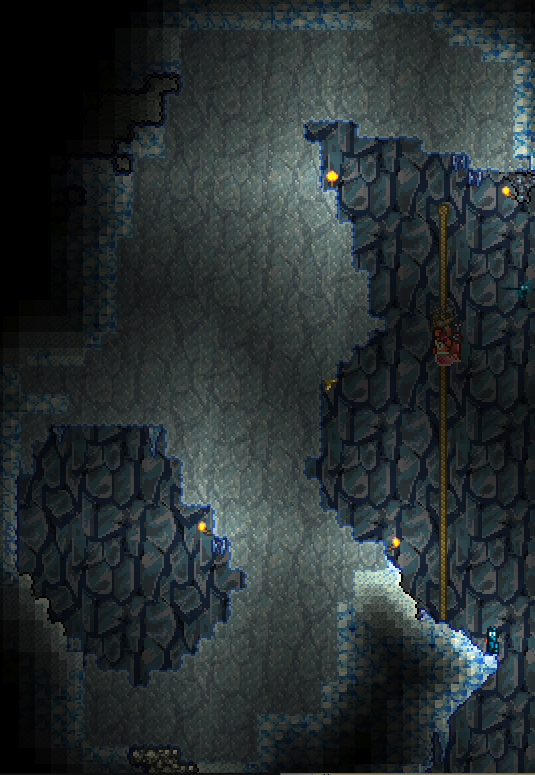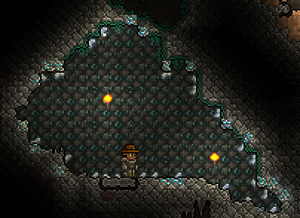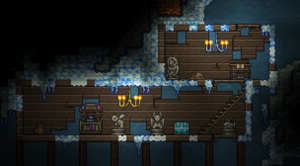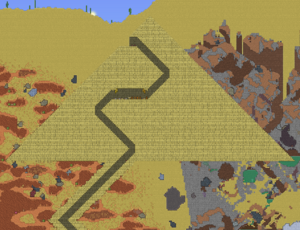Biomes (Biomes/es)
Los biomas, también llamados entornos, son distintos tipos de paisajes del mundo de Terraria. Cada entorno tiene objetos y únicos relacionados con su temática.
El más conocido es el Bosque, situado en la superficie.
Entornos de la superficie
Aparecen sobre los 0 pies y están al aire libre.
Bosque
Forests are the most common surface biome, and are where the player spawns at the start of any world. Green Grass grows across the dirt, which can spawn mushrooms, Daybloom, and Trees. Vines can grow from the bottom of grass covered dirt blocks if they have a space beneath them. The area is still considered forest even if there are no actual trees there, as forest is basically anywhere on the surface where no other Biome exists. However, trees can only grow on grass-covered dirt. Forests are considered lower-end environments because the player begins there, and only weaker enemies spawn.
Nieve
Snow biomes are winter-themed biomes, in which any kind of dirt is replaced by Snow Blocks and stone replaced by ice. As of the 1.2 update, the Holiday themed Snow Biome was converted to a full biome and now takes up a significantly larger portion of the map (comparable to the Jungle). It now has its own background, soundtrack and water color, similar to most other biomes. And it's the only biome with a particle effect (falling snow flakes). It is resistant to both the Hallow and Corruption biomes, however, this does not stop corruption or hallow from generating in it. For example, if corruption is generated inside an Ice biome, then the chasms normally seen in corruption biomes will be present, and ice replaced by purple ice, the snow left unaffected. Slush is the equivalent of silt in this biome. The Snow Biome is always located opposite to the Jungle and thus on the same side as the Dungeon.
Desierto
Los desiertos son grandes extensiones de Arena. Son bastante comunes entre los Bosques, y se generan buitres y hormigas león, con los que los nuevos jugadores deben tener cuidado. Debido a que la arena se ve afectada por la gravedad, es muy fácil de tener grandes cantidades de arena simplemente cavando a unos bloques de profundidad y cavar horizontalmente. No te pongas al lado de la columna de arena mientras haces esto, ya que la arena que cae inflige daño cuando cae encima de un jugador. Aquí también crecen cactus.
Jungla
The Jungle is one of the surface biomes, composed primarily of Grass, Vines, Mud and Jungle Trees. The sky turns a vibrant green within the jungle. The jungle contains Piranha, Jungle Bats, Snatchers and other creatures. The Jungle Trees can not be grown intentionally, but instead randomly grow without the use of acorns. The Jungle will always be located on the opposite side of the map from the Snow and Dungeon.
La Corrupción
Every world has a section of Corruption or Crimson. Small worlds have 1 or 2 sections (usually with one in either direction from the spawn point), Medium worlds have around 2 or 3, and Large worlds can have up to 4. The monsters that spawn in the Corruption are powerful and spawn regardless of the time of day. The purple grass of the corruption can be removed with Purification Powder or the quick swing of a pickaxe. The spreading of the corruption can be prevented by either placing any block other than dirt at its edge, or by planting a Sunflower, which can be found randomly in the world or bought from a Dryad. (In Hardmode, the spreading Corruption will uproot sunflowers. Try placing Ash or Clay instead.) The purple stone found in the corruption is called Ebonstone, and can only be mined by Bomb and Dynamite or any pickaxe/drill more powerful than a Gold Pickaxe. A newer player should not try to cross The Corruption without a set of decent gear, as well as either a good grasp on block placement for pits or an item that allows vertical travel (like a Grappling Hook). As of 1.2, using Ropes makes traveling in the deep chasms of the corruption a lot easier, whenever you have enough defense.
El Carmesí
A new biome introduced in version 1.2.0.3, the Crimson has a chance of replacing the Corruption in a newly-generated world. While it is similar to the corruption in difficulty, it contains new monsters and is the only place where the Brain of Cthulhu can be summoned. It is also structurally different than the Corruption, possessing 1 or 2 massive caverns, accessible from a distinct surface formation, rather than multiple ravines leading to a large horizontal tunnel. Though the landscape is generally easier to navigate, it is considered a harder version of Corruption by players with a more challenging boss and higher difficulty mobs. (Generally in Hardmode)
Champiñón
The mushroom biome does not occur naturally on the surface but can be cultivated by planting glowing mushroom seeds in surface-level mud. Regardless of the time of day it will always appear as night time there, though whether this is intentional, a bug, or simply to allow for the mushrooms to glow is not known. The mushroom biome spawns challenging enemies during the Blood Moon, as well as smaller, more manageable enemies, so it is not recommended for new players to create surface level mushroom biomes near their spawn points.
Océano
At each end of every map there will be a deep body of water. This water is not infinite, and can be drained like any other body of water. Oceans will almost always spawn with Water Chests, usually quite a distance away from shore. The items inside will often be water-related, like Flippers and Breathing Reeds. The ocean is a relatively dangerous place for the newer player as it houses enemies like the Shark and the Jellyfish. It's also easy to drown if you venture too far down without proper gear. Wings or Rocket Boots can save your life if you start drowning, as they allow easy access out quickly.
Entornos subterráneos
Underground biomes appear below 0 feet and have a background wall. Daylight does not shine here so it's best to bring a light source at all times. The underground has three principal depths:
Underground/es
Below the 0ft depth level you will be in the Underground. The music will change when you pass this point, and stronger monsters will spawn. This layer is considered completely separate from the surface, so if a Blood Moon rises it will not affect you, other than causing Goldfish to become Corrupt Goldfish. The Underground is the second biggest biome. The treasure found here is mid-level, and very valuable to players who are ready for more adventure. The player may also encounter their first Worm: the Giant Worm. This can be an annoying opponent for characters with low-level equipment, so make sure to have plenty of room to maneuver when fighting these.
Cueva
As the biggest biome in Terraria, The Cavern is massive - on Large maps, it is easily 50% of the entire world. It encompasses the Underground Jungle and the bottom part of the Dungeon. It's also home to a harder set of monsters (including Skeletons, which drop the much-needed Hook). The treasure here is similar to the Underground, but with occasional patches of Glowing Mushrooms.
The Underworld/es
Being by far one of the hardest levels to reach (and more importantly, to survive in), the Underworld is a dangerous lava-filled area comparable to Hell. But the risk is compensated by reward - within the Ash and lava wells are deposits of Hellstone, the most powerful crafting material in the game (before Hardmode). But Hellstone is also dangerous to the touch, so it would be wise for you take an Obsidian Skull or a similar item to prevent damage. As of version 1.0.6, any Hellstone in the Underworld layer will now create lava when mined. There are also towers of burning-hot Hellstone Brick or the relatively safe Obsidian Brick. You can also find Hellforges down here, which is an upgrade to the Furnace. A wide variety of dangerous monsters can spawn down here: Fire Imps, Bone Serpents, Lava Slimes, Demons, and Hellbats. The Fire Imps use the Caster AI and will chase the player. Bone Serpents are more powerful Giant Worms that are much larger and harder to kill. Lava Slimes swim straight over the lava towards you. Hellbats and Demons are powerful flying monsters that can deal a lot of damage unless you're properly equipped. It is highly recommended that you do not enter The Underworld unprepared; Death does happen even to the most seasoned players. In the 1.2 update, defeating one of the hardmode bosses (The Twins, Skeletron Prime, The Destroyer) will cause other mobs like the Red Devil and Lava Bat to spawn in the underworld. Wall of Flesh can be summoned
Entornos de temática subterránea
Nieve subterránea
 The Cavern layer equivalent to the snow biome. Many ledges and bodies of water will have a thin layer of ice over them, and while they can support the player's weight they can break if you land on them with high enough speed. Ice Chests are found in this biome with ice themed equipment. It contains more dangerous enemies than the surface level, including both spiked ice slimes that fire projectiles and undead vikings. Gemstones are common and can stick out of the blocks, creating a faint glow. The Underground snow biome does not exist past the area that Lava starts to spawn for obvious reasons, thus, it does not reach the Underworld.
The Cavern layer equivalent to the snow biome. Many ledges and bodies of water will have a thin layer of ice over them, and while they can support the player's weight they can break if you land on them with high enough speed. Ice Chests are found in this biome with ice themed equipment. It contains more dangerous enemies than the surface level, including both spiked ice slimes that fire projectiles and undead vikings. Gemstones are common and can stick out of the blocks, creating a faint glow. The Underground snow biome does not exist past the area that Lava starts to spawn for obvious reasons, thus, it does not reach the Underworld.
Champiñón subterráneo
This biome features glowing mushrooms on top of mud, and if there is enough height in the cavern giant mushrooms can grow as well. The background is unique to the biome and can, extremely rarely, replace a good portion of the Jungle but still generate some jungle, hives, and shrines.
Underground Jungle/es
The Underground Jungle is one of the higher-tier biomes in the game, and is found at Cavern depth under the surface of the Jungle. The Jungle will have vegetation in the form of light-blocking vines, various flowers, glowing spores, and thorns. The monsters that spawn here (such as Hornets and Man Eaters) can inflict impressive damage to unprotected players. The biome also features the Bee Hive limited biome and occasional jungle shrines containing higher tier treasure. After the Mechanical Bosses, The Destroyer, The Twins, and Skeletron Prime, have been defeated, the game will say "The jungle grows restless...". In the Underground Jungle, Plantera's Bulbs will spawn, allowing the player to summon the Jungle boss. The Jungle also contains the Jungle Temple, considered the hardest, and last, Hardmode "Biome".
Entornos del hardmode
Van apareciendo a medida que desbloqueas el hardmode.
The Hallow/es
The Hallow is the "anti-corruption" biome, which is automatically created once the player activates hardmode by defeating the Wall of Flesh. It can be created with Hallowed Seeds and will stop the Corruption from spreading, but it also takes over adjacent biomes. The biome has light blue grass and colored trees. It also has its own underground biome. The Dryad will tell the player the percentage of Hallow and Corruption in the world after the player has defeated the Wall of Flesh boss in the Underworld. Unicorn and Pixie enemies will spawn here.
Underground Hallow/es
The Underground Hallow/es occurs when The Hallow spreads in the Cavern; this is easily noticeable because it's the only place where Crystal Shards spawn on blocks. Illuminant Slimes, Illuminant Bats, Chaos Elementals, and Enchanted Swords can be found here. It has a different soundtrack from the overworld Hallow (the same one used in the 1.1 trailer), and is the only place to get Souls of Light.
Underground Corruption/es
The Underground Corruption/es is created in the Cavern/es layer upon defeating the Wall of Flesh. It shares the same feel as the overworld Corruption, but has different enemies, a different soundtrack (a mix of the regular Underground and Corruption soundtrack), and it's the only place to find Souls of Night and Cursed Flames. All enemies from the overworld version are present, as well as World Feeders, Clingers, and Cursed Hammers.
Underground Crimson/es
The alternative to the Underground Corruption, which functions and is spawned in mostly the same way. The Underground Crimson, like the Corruption variety will have enemies occasionally drop Souls of Night, but Cursed Flames are not to be found. Instead, Enemies known as Ichor Stickers will drop Ichor. Also found in this biome are Floaty Gross, Crimson Axe and Pigron monsters.
Corrupted/Crimson Deserts y Hallowed Deserts
When the world enters Hardmode, several deserts of the world will become either corrupted, crimsoned or hallowed. These three sub-biomes have their own backgrounds, and spawn unique versions of the Mummy (the Light Mummy and Dark Mummy, corresponding to the biome) which drop components needed to craft the Dao of Pow. Sand will be replaced with Ebonsand, Crimsand,or Pearlsand, much like Stone is replaced in other themed biomes. Cactus, while colored differently (Purple, Blue, Red) still drop regular cactus. Crimson deserts are functionally the exact same as their corrupted counterparts, with the exception that the sand is instead turned into Crimsand, and Cactus becomes red. Dark Mummies still spawn just like Corruption.
Entornos limitados o eventuales
Biomes in this category tend to be small in number and size or created by an event. They have unique characteristics and monster spawns.
Lluvia
The most common event biome is Rain. Rain can occur in any biome, and when it occurs the music changes, the background and lighting dims, and Goldfish jump or walk on their fins and some new monsters may spawn, like Umbrella Slime and Flying Fish. Also, Zombies sometimes spawn with Rain Coats and Rain Hats at night. Rain will spawn Rainbow Slimes in Hallow biomes as well, albeit rarely. Once the rain has completed the effect fades away and the affected biome returns to normal. Rain in the snow biome becomes a blizzard.
Mazmorra
Along with the Underground Jungle, the Dungeon is considered one of the higher-end biomes. The dungeon is a very large Pink, Blue, or Green brick building with an Old Man near the door. If you go into the Dungeon before Skeletron is defeated, Dungeon Guardians will spawn and kill you (if you travel below 0 depth). The dungeon itself runs very deep with many passages leading around and in many directions. Spikes also cover floors and walls in many parts of the dungeon, and do considerable damage to players (but not monsters). The items found here are rare and valuable, and some are not found anywhere else. The monsters that spawn here are powerful and come in great numbers. There are also Water Candles around the dungeon - while they are around, monster spawn rates are increased. The books located around the dungeon also may house the Water Bolt spell. When entering the dungeon for the first time, make sure you have a full stack of potions and plenty of Inventory space. It also helps to have some kind of vertical transport (Rocket Boots or a Grappling Hook).
Meteorito
This mid-tier biome is special: whenever a Shadow Orb or a Crimson Heart is smashed, there is a chance that within the next day the game will spawn a meteor and display the message "A meteorite has landed!". The meteor will crash land and turn a large portion of the surrounding tiles into Meteorite. Meteorite will burn the player if they do not have an Obsidian Skull, an Obsidian Shield, an Ankh Shield, a pair of Obsidian Water Walking Boots, a pair of Lava Waders, an Obsidian Horseshoe equipped, or are using an Obsidian Skin Potion. Meteorite also requires the player to have a Tungsten Pickaxe, Gold Pickaxe Platinum Pickaxe, or better, as lower level pickaxes cannot break it into ore. Dynamite can also be used to great effect. While there are more than 50 blocks of Meteorite left in the area, Meteor Heads will spawn. These monsters can fly through solid objects and will ram the player for a respectable amount of damage. One of the best ways to deal with them is to use a vilethorn, as one shot can kill a whole cluster of meteor heads. Despite the danger, Meteorite gear is a great step up for the newer player.
Islas flotantes
The Floating Islands are some of the smallest biomes that the player will come across. Due to their location in the sky they are also one of the harder biomes to reach. Finding them is not an easy task, but can be accomplished by using a Gun with Meteor Shot or the Water Bolt spell, both of which bounce off objects. Once found, simply build a tower or use a Gravitation Potion to float up to it. The items on Floating Islands are very useful, and will serve most players well even in the end game and since the 1.2 update they won't require Keys. The monsters that spawn here will be the same as the monsters as from the Forest biome, as well as Harpies (and Wyvern on hardmode) When Hardmode is initiated, if a floating island is in line with the generation of hallow/corruption, the island will be converted to it. Although rare, Meteors can hit a floating island. As of the 1.2 update, Floating Islands contain a plethora of unique materials, including Clouds, Rainclouds and the House will be made of and contain Skyware items.
Árboles gigantes
Living Trees are huge, thick trees that can be generated. Cutting the tree yields regular Wood. Some of those trees can be hollow and lead deep underground. There may be rooms containing Living Wood Chests with related loot inside, as well as Living Wood Doors, Living Wood Chairs, Living Wood Tables and other Living Wood furniture.
Spider Nest/es
Spider Nests are rare mini-biomes that can be located underground, noted by the black background wall and the numerous webs filling the area. This biome will spawn Wall Creepers when entered. The Cobwebs filling this area rapidly grow back, which is a unique feature of the biome. Spider Nests are the only location where one can find Web Covered Chests and all unique treasures discovered therein. Also the Stylist NPC is found in this biome.
Panal de abejas
The Bee Hive occurs in the Underground Jungle. Bee Hives are made from Hive blocks and contain Honey and crystallized larva. If you destroy the larva, it will summon the Queen Bee boss.
Jungle Temple/es
A Biome found in the underground jungle, the Jungle Temple is an end-game biome that can be accessed with a key dropped by Plantera. Though a hard-mode level biome, the Temple can be entered at any time in a new world assuming the player has a key or the Picksaw to dig into the temple's bricks. Inside, one will find that immense danger awaits them, filled to the brim with spear and spike ball traps and dangerous Lihzahrd and flying serpent monsters. It is highly suggested to stay off the ground, as all traps are pressure plate activated. Chests found in this area will always contain Lihzahrd power cells, used to activate an altar at the end which summons the Golem/es.
Espacio
Space is a layer appearing at the top of the world: ~950 feet and above, for large worlds. The sky is dark and stars are visible, even when the Sun is still up, and gravity affects players less. Nothing much happens in Space, though an exclusive background and music will be present.
Salas del tesoro
Treasure rooms are spawned with world creation and appear to be man-made structures. They always contain some form of treasure and sometimes have light sources, furniture, and other decorations. Unless otherwise noted the walls, contents and backgrounds of these rooms can be harvested. Treasure rooms include:
Underground Cabin/es
Underground cabin/ess are typically wooden buildings full of dusty, broken furniture as well as chests, vases, and occasionally usable furniture and decorations. They are found in the underground in the cavern, glowing mushroom and snow biomes.
Jungle Shrine/es
Jungle Shrine/ess are small brick buildings and typically contain only a single chest and a light source. They are found in the underground jungle and several can appear in one biome.
Ruined House/es
Ruined houses are generated at World creation in The Underworld in the middle third of the Underworld (laterally). They are towers with multiple levels, constructed with missing parts for a "ruined" look, from Obsidian Brick or Hellstone Brick. They are sometimes partially submerged in lava and often contain deposits of hellstone just outside their walls.

Gemstone Cave
A Gemstone Cave is filled with concentrated gem deposits of one or more varieties and features a unique background (a gemstone wall) that is speckled with gems of the same color found in the Gemstone Cave. Unfortunately, the gemstone wall cannot be harvested and is instead destroyed by the hammer. Gemstone caves are found in the cavern and underworld levels, and unlike other treasure rooms are natural rather than artificial structures.
Sky Cabin
Sky Cabins are the main feature of a floating island. In 1.2 they were redesigned, changing from former brick shrines to colorful sky cabins with new blocks, new walls and unique furniture. The skyware chest inside contains treasure only found on floating islands. Have fun on your magic island.
Pirámides
The pirámide is a rare spawn in the desert. It is made of sandstone brick and contains narrow passages delving deep into the earth. The treasure room is filled with coins, vases and a gold chest that can have unique loot.





























